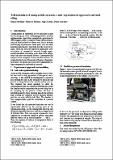Por favor, use este identificador para citar o enlazar a este item:
http://hdl.handle.net/10261/210931COMPARTIR / EXPORTAR:
 SHARE
BASE SHARE
BASE
|
|
| Visualizar otros formatos: MARC | Dublin Core | RDF | ORE | MODS | METS | DIDL | DATACITE | |

| Título: | Triboemission of nanoparticle aerosols: a new experimental approach and modelling |
Otros títulos: | Triboemission; Nanoparticle aerosols; Wear of nanomaterials | Autor: | Nevshupa, Roman CSIC ORCID; Rubiano, Francisco CSIC ORCID; Castillo, Ángel CSIC ORCID; Castellote, Marta CSIC ORCID | Fecha de publicación: | 2019 | Citación: | ECOTRIB (2019) | Resumen: | Contamination of breathable air by particulate matter has becoming one of the challenging problems in urban agglomeration. Apart from nanoparticle generation by diesel engines, there is a number of non-exhaust sources, many of which related to triboemision due to abrasion and wearing of pavements, brake pads, tires and other materials and elements. This work describes a new technique, which has been developed for quanti-tative characterization of nanoparticle aerosols though experimental simulation on various scales from basic laboratory-scale tests to in situ real-life test. A new method for analysis of the nanoparticle emission rate has been developed on the basis of the model of bal-ance of nanoparticle flows. The model has been tested using natural airborne nanoparticles and artificial aerosols. | Descripción: | Trabajo presentado a ECOTRIB (European Conference on Tribology), celebrada en Austria del 12 al 14 de junio de 2019. | URI: | http://hdl.handle.net/10261/210931 |
| Aparece en las colecciones: | (IETCC) Comunicaciones congresos |
Ficheros en este ítem:
| Fichero | Descripción | Tamaño | Formato | |
|---|---|---|---|---|
| triboaeroso.pdf | 164,12 kB | Adobe PDF |  Visualizar/Abrir |
CORE Recommender
Page view(s)
104
checked on 18-abr-2024
Download(s)
85
checked on 18-abr-2024
Google ScholarTM
Check
NOTA: Los ítems de Digital.CSIC están protegidos por copyright, con todos los derechos reservados, a menos que se indique lo contrario.
